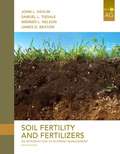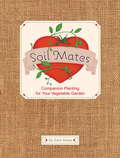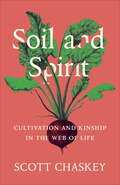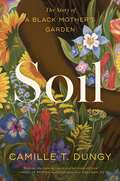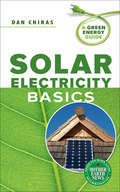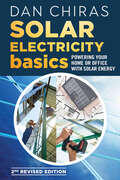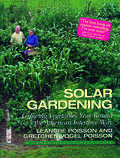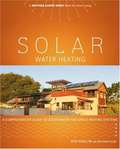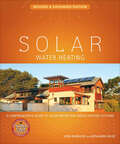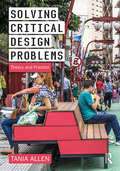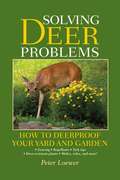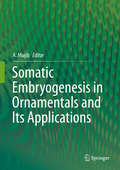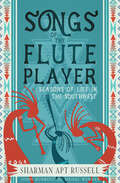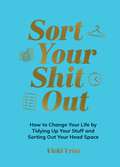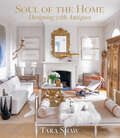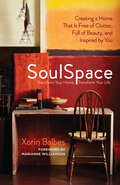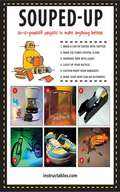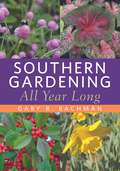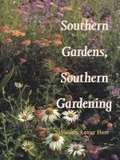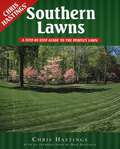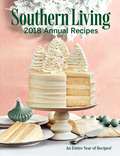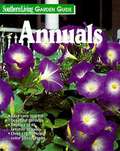- Table View
- List View
Soil Fertility and Fertilizers: An Introduction to Nutrient Management, Eighth Edition
by John L. Havlin Samuel L. Tisdale Werner L. Nelson James D. BeatonSoil Fertility and Fertilizers: An Introduction to Nutrient Management, Eighth Edition, provides a thorough understanding of the biological, chemical, and physical properties affecting soil fertility and plant nutrition. Covering all aspects of nutrient management for profitable crop production, the text pays particular attention to minimizing the environmental impact of soil and fertilizer management. The eighth edition of this proven text has been substantially revised to reflect rapidly advancing knowledge and technologies in both plant nutrition and nutrient management.
Soil Mates
by Kelle Carter Sara AlwayMatchmaking in the garden! In this charming guide to companion planting for your vegetable-garden favorites, you'll learn why Broccoli Rosemary and whether Cucumber + Corn = friends with benefits. (Just watch out for Celery! Leggy and leafy, she is notoriously easygoing and will happily settle down with just about anyone, raising a ruckus in your raised beds.) Complete with 20 pairings, tasty recipes, prep-aration tips, and more, Soil Mates is the perfect partner for your horticultural matchmaker.
Soil Science for Gardeners: Working with Nature to Build Soil Health
by Robert PavlisBuild healthy soil and grow better plantsRobert Pavlis, a gardener for over four decades, debunks common soil myths, explores the rhizosphere, and provides a personalized soil fertility improvement program in this three-part popular science guidebook.Healthy soil means thriving plants. Yet untangling the soil food web and optimizing your soil health is beyond most gardeners, many of whom lack an in-depth knowledge of the soil ecosystem.Soil Science for Gardeners is an accessible, science-based guide to understanding soil fertility and, in particular, the rhizosphere – the thin layer of liquid and soil surrounding plant roots, so vital to plant health.Coverage includes:Soil biology and chemistry and how plants and soil interactCommon soil health problems, including analyzing soil's fertility and plant nutrientsThe creation of a personalized plan for improving your soil fertility, including setting priorities and goals in a cost-effective, realistic time frame.Creating the optimal conditions for nature to do the heavy lifting of building soil fertilityWritten for the home gardener, market gardener, and micro-farmer, Soil Science for Gardeners is packed with information to help you grow thriving plants.
Soil and Spirit: Cultivation and Kinship in the Web of Life
by Scott ChaskeyAs a farmer with decades spent working in fields, Scott Chaskey has been shaped by daily attention to the earth. A leader in the international Community Supported Agriculture (CSA) movement, he has combined a longstanding commitment to food sovereignty and organic farming with a belief that humble attention to microbial life and diversity of species provides invaluable lessons for building healthy human communities. Along the way, even while planning rotations of fields, ordering seeds, tending to crops and their ecosystems, Chaskey was writing. And in this lively collection of essays, he explores the evolution of his perspective—as a farmer and as a poet. Tracing the first stage in his development back to a homestead in Maine, on the ancestral lands of the Abenaki, he recalls learning to cultivate plants and nourish reciprocal relationships among species, even as he was reading Yeats and beginning to write poems. He describes cycling across Ireland, a surprise meeting with Seamus Heaney, and, later, farming in Cornwall’s ancient landscape of granite, bramble, and windswept trees. He travels to China for an international conference on Community Supported Agriculture, reading ancient wilderness poetry along the way, and then on to the pueblo of Santa Clara in New Mexico, where he joins a group of Indigenous women harvesting amaranth seeds. Closer to home on the Southfork of Long Island, he describes planting redwood saplings and writing verse under the canopy of an American beech.“Enlivened by decades of work in open fields washed by the salt spray of the Atlantic”—words that describe his prose as well as his vision of connectedness—Scott Chaskey has given us a book for our time. A seed of hope and regeneration.
Soil: The Story of a Black Mother's Garden
by Camille T DungyA &“heartfelt and thoroughly enriching&” (Aimee Nezhukumatathil, New York Times bestselling author of World of Wonders) work that expands on how we talk about the natural world and the environment as National Book Critics Circle finalist Camille T. Dungy diversifies her garden to reflect her heritage.In Soil: The Story of a Black Mother&’s Garden poet and scholar Camille T. Dungy recounts the seven-year odyssey to diversify her garden in the predominantly white community of Fort Collins, Colorado. When she moved there in 2013, with her husband and daughter, the community held strict restrictions about what residents could and could not plant in their gardens. In resistance to the homogenous policies that limited the possibility and wonder that grows from the earth, Dungy employs the various plants, herbs, vegetables, and flowers she grows in her garden as metaphor and treatise for how homogeneity threatens the future of our planet, and why cultivating diverse and intersectional language in our national discourse about the environment is the best means of protecting it. &“Brilliant and beautiful&” (Ross Gay, New York Times bestselling author of The Book of Delights), Soil functions as the nexus of nature writing, environmental justice, and prose to encourage you to recognize the relationship between the people of the African diaspora and the land on which they live, and to understand that wherever soil rests beneath their feet is home.
Solar Electricity Basics: A Green Energy Guide (Mother Earth News Books for Wiser Living)
by Dan ChirasThe future will be powered by renewables. As we transition away from finite and polluting fossil fuels, clean, reliable, and affordable renewable technologies such as solar electricity will become the mainstay of our energy supply. Solar Electricity Basics provides a clear understanding of electricity and energy. It discusses the types of solar electric system you can choose from, their components, solar site assessment, the installation of photovoltaic systems, and much more. Whether your goal is to lower your energy bill or to achieve complete energy independence, Solar Electricity Basics is the introduction you need.
Solar Electricity Basics: Powering Your Home or Office with Solar Energy
by Dan ChirasA guide to choosing and using solar electricity systems from &“the man who launched a thousand rooftop solar arrays . . . the essential go-to manual&” (John D. Ivanko and Lisa Kivirist, coauthors of ECOpreneuring). As we look for safer, more economical, and more sustainable ways to meet our needs for electricity—and as more and more electric cars hit the road—solar has become an increasingly popular option. With Solar Electricity Basics, renewable energy expert Dan Chiras offers a concise and up-to-date guide covering all the essentials. It explores:How to size, cost, and choose the right system, including off-grid vs. grid-tied vs. grid-tied with battery backupWhere to mount a system for maximum performanceWhat type of modules and inverters to buyHow to install and maintain batteriesCost vs. benefit for solar electric systemsHow to connect to the grid, and what type of net metering your area offersSolar Electricity Basics is an indispensable guide for homeowners, business owners, builders, and students for figuring out solar electricity quickly and easily.
Solar Gardening
by Leandre Poisson Gretchen Vogel Poisson"Solar Gardening" shows how to increase efforts of the sun during the coldest months of the year and how to protect tender plants from the intensity of the scorching sun during the hottest months through the use of solar "mini-greenhouses. " The book includes instructions for building a variety of solar appliances plus descriptions of more than 90 different crops, with charts showing when to plant and harvest each. The result is a year-round harvest even from a small garden. In "Solar Gardening" the Poissons show you how to:• Dramatically increase the annual square-foot yield of your garden. • Extend the growing and harvest season for nearly every kind of vegetable. • Select crops that will thrive in the coldest and hottest months of the year, without artificial heating or cooling systems. • Build solar appliances for your own garden. Armed with nothing but this book and a few simple tools, even novice gardeners can quickly learn to extend their growing season and increase their yields, without increasing the size of their garden plot.
Solar Home Heating Basics
by Dan ChirasAs fossil fuel supplies dwindle, home heating will be one of the major challenges in temperate and cold climates in upcoming years. The reserves of natural gas used to heat the majority of North American buildings are rapidly being depleted. This latest Green Energy Guide helps readers who want to slash their energy bills and reduce their dependence on scarce resources to navigate the sometimes confusing maze of clean, reliable, and affordable options.Solar Home Heating Basics focuses on renewable energy strategies to heat new and existing homes and small businesses. These include:*Energy efficiency, weatherization, and insulation*Solar hot air heating*Solar thermal systems*Passive solar heating*Backup heating systemsWhile most solar home heating resources are geared primarily towards new buildings, this practical guide addresses ways of retrofitting existing buildings, making solar a reality for many people.Packed with all the essential information home and small business owners need to find alternatives to conventional heating solutions, Solar Home Heating Basics is your key to a personal energy solution.Dan Chiras is a respected educator and the author of thirty books on residential renewable energy and green building, including The Homeowner's Guide to Renewable Energy and Power from the Sun. Dan is the director and lead instructor at the Evergreen Institute's Center for Renewable Energy and Green Building, where he teaches workshops on energy efficiency, solar electricity, solar hot water, small wind energy, green building, natural plasters, and natural building.
Solar Rooftop DIY: The Homeowner's Guide to Installing Your Own Photovoltaic Energy System (Countryman Know How)
by Mike SullivanThe do-it-yourself guide for converting your home to solar power Solar energy is clean, efficient, sustainable--and expensive. Or is it? Many homeowners simply assume that the cost of solar panels is out of their reach, but in reality, the technology is quickly becoming attainable for the middle class. Rather than leasing panels from one of those home solar startups (and letting them reap the financial benefits), why not join the thousands who are doing it themselves? In Solar Rooftop DIY, sustainable energy expert Mike Sullivan offers five design plans--ranging from a few simple panels to a complex, roof-covering array--for building a rooftop PV energy system for any home. Each plan has clear and detailed step-by-step photographs showing the installation process. Many of them require no additional labor--just a few days' commitment for the average weekend warrior. With energy costs only set to increase in the future, now is the time to make the switch to solar and start selling power back to the grid.
Solar Water Heating: A Comprehensive Guide to Solar Water and Space Heating Systems
by Bob Ramlow Benjamin NuszSolar Water Heating is a practical solar encyclopedia for anyone interested in installing a solar energy system or in starting a solar energy company. The folksy writing is clear and the numerous diagrams make this book a great resource for everyone from the novice just getting started to the existing solar professional looking to pick up some of Bob Ramlow's many useful observations from a long career installing and maintaining solar energy systems. - Don Wichert, Director, Renewable Energy Programs, Wisconsin Energy Conservation Corporation HEATING WATER WITH THE SUN is almost as old as humankind itself, and it is done all over the world. Yet there are few resources in North America for those who want to install such systems themselves. Solar Water Heating fills this gap. It reviews the history of solar water & space heating systems from prehistory to the present, then presents the basics of solar water heating, including an introduction to modern solar energy systems, energy conservation and energy economics. Drawing on the author's experience as an installer of these systems, the book goes on to cover: Types of solar collectors, solar water and space heating systems and solar pool heating systems, including their advantages and disadvantages. System components, their installation, operation, and maintenance. System sizing and siting Choosing the appropriate system. the book focuses especially on the financial aspects of solar water or space heating systems, clearly showing that such systems can save significant costs in the long run. Well-illustrated, the book is designed for a wide readership from the curious to the student or professional. [this book] will be required reading for all of our new installation personnel since it provides a complete and comprehensive history, guide and information about the type of work we do every day. - Richard Lane, Managing Partner, Solar Mining Company
Solar Water Heating: A Comprehensive Guide to Solar Water and Space Heating Systems (Mother Earth News Books for Wiser Living)
by Bob Ramlow Benjamin NuszHeating water with the sun is a practice almost as old as humankind itself. Solar Water Heating , now completely revised and expanded, is the definitive guide to this clean and cost-effective technology. Beginning with a review of the history of solar water and space heating systems from prehistory to the present, Solar Water Heating presents an introduction to modern solar energy systems, energy conservation and energy economics. Drawing on the authors' experiences as designers and installers of these systems, the book goes on to cover:Types of solar collectors, solar water and space heating systems and solar pool heating systems, including their advantages and disadvantagesSystem components, their installation, operation, and maintenanceSystem sizing and sitingChoosing the appropriate system.This book focuses on the financial aspects of solar water or space heating systems, clearly showing that such systems generate significant savings in the long run. With many diagrams and illustrations to complement the clearly-written text, this book is designed for a wide readership ranging from the curious homeowner to the serious student or professional.
Solving Critical Design Problems: Theory and Practice
by Tania AllenSolving Critical Design Problems demonstrates both how design is increasingly used to solve large, complex, modern-day problems and, as a result, how the role of the designer continues to develop in response. With 13 case studies from various fields, including program and product design, Tania Allen shows how types of design thinking, such as systems thinking, metaphorical thinking, and empathy, can be used together with methods, such as brainstorming, design fiction, and prototyping. This book helps you find ways out of your design problems by giving you other ways to look at your ideas, so that your designs make sense in their setting. Solving Critical Design Problems encourages a design approach that challenges assumptions and allows designers to take on a more critical and creative role. With over 100 images, this book will appeal to students in design studios, industrial and product design, as well as landscape and urban design.
Solving Deer Problems: How to Deerproof Your Yard and Garden (Lyons Press Ser.)
by Peter LoewerWhat can I do? Gardeners are asking themselves--and experts--this question with increasing urgency about the deer that threaten their carefully cultivated lawns and gardens. With the increased development of suburban and rural land and the lack of natural predators, deer populations are exploding and living closer to humans than ever before--and they’re nibbling on more beloved blooms as well. How can the deer be stopped? What plants are safe? Peter Loewer has the answers in Solving Deer Problems. In this manual, he addresses several key topics, including plants that will withstand a whitetail attack, chemicals that can safely be used as deer repellants, fences that will keep deer away from those choice garden beds, trapping and relocating cervids and other garden pests, and numerous tricks to keep the pesky creatures out of your yard. Peter also discusses the less-prominent threat of deer-borne diseases and ticks and how to protect yourself and your pets. He even touches on car vs. deer collisions and how you can prepare yourself to achieve the best outcome incase a deer is ever caught in your headlights. Don’t wait until your prize flowers, vegetables, or shrubs are a deer’s meal. Pick up Solving Deer Problems for all the clear answers on what you can do about your deer problem.
Somatic Embryogenesis in Ornamentals and Its Applications
by A. MujibSomatic embryogenesis (SE) is a unique process by means of which a vegetative/somatic plant cell transforms into an embryo. This in vitro embryogeny has immense fundamental and practical applications. The SE process is complex and is controlled by a variety of external and internal triggers. This book compiles the latest advances in embryogenesis research on ornamentals and discusses the importance of embryogenic cultures/tissues in raising transgenic crops. The technique of cryopreservation in the protection of ornamental genetic resources is discussed using embryogenic culture/embryo as the tissue of choice, and the respective roles of the genotype, plant growth regulator, environment and other regulating factors in embryogenesis are discussed. The book also focuses on comparative biochemical and physiological differences during the acquisition and development of embryos. The importance of plant proteome and functional genomics as a source of markers is highlighted, and special attention is paid to genes / gene homologues (SERC) in characterizing embryogenesis. Lastly, the book examines the involvement of auxin polar transport and other molecular networks regulating gene expression.
Songs of the Fluteplayer: Seasons of Life in the Southwest
by Sharman Apt RussellFilled with &“honest&” writing and &“wise&” observations, &“Russell&’s well-written essays describe her life as an urban immigrant to the rural Southwest&” (Library Journal). In 1981, newlywed Sharman Apt Russell moved with her husband to an agricultural valley in southwestern New Mexico, hoping to create a simpler life. From building their adobe house to the home-birth of their firstborn to growing their own food and navigating the seasonal flooding of the Mimbres River, these luminous essays chart Sharman&’s journey toward self-sufficiency in a land as mythical and remote as the image of the prehistoric fluteplayer found on the pottery in trading posts throughout the Southwest. Replete with wisdom and a reverence for the Native American people whose relics Sharman discovers everywhere on the land around her, this award-winning memoir pays tribute to the power and grace of nature, our deep connection to our prehistoric past, and the beauty of living in communion with the land. &“A fine contribution to the literature of the modern American Southwest . . . [Russell] achieves just the right mix of fact and metaphor, humor and poetics.&” —Booklist &“These essays say much about the difficulty of maintaining an alternate lifestyle.&” —Publishers Weekly &“A lovely little book. To be kept and read and read again.&” —Tony Hillerman, bestselling author
Sort Your Shit Out: How to Change Your Life by Tidying Up Your Stuff and Sorting Out Your Head Space
by Vicki Jane VrintDiscover practical hacks and invaluable tips to help you conquer the chaos of everyday life, one step at a timeWhether you're drowning in a sea of physical clutter, tangled in a web of scattered goals, or overwhelmed by the mental chaos, this book has your back.This simple, no-nonsense guide isn't just about tidying up; it's a life-changing toolkit for untangling the mess in both your physical and mental space. The super-achievable ideas in these pages will help you organize your stuff and organize your life for a more focused, intentional, and streamlined existence.Inside you will find practical solutions to help you:- Tackle the different categories of clutter in your home, one by one- Manage your time and set helpful, achievable routines for ultimate well-being- Conquer financial challenges and fine-tune your spending for peace of mind- Create simple systems for keeping your clothes, paperwork, gadgets (and much more!) in orderSay goodbye to the overwhelm and say hello to a revitalized sense of control.
Soul of the Home: Designing with Antiques
by Tara ShawPast meets present in this stylish guide to decorating modern homes with heirlooms and antiques. Designer and antiques dealer Tara Shaw is a respected supplier of French and European antiques for a host of AD100 and Elle Decor A-listers, including Bobby McAlpine, Mary McDonald, and Bunny Williams. In her first book, she helps readers understand how to select the best antiques and how to use them in a variety of decor schemes. The book presents never-before-published spaces from Shaw’s portfolio and reveals her favorite antique-hunting spots throughout Europe. Anecdotes from years of treasure hunting are accompanied by images of rare and precious finds, with text that decodes just how to choose the right pieces and display them in a contemporary interior. Readers will be able to look at each space and take away ideas they can apply to their own homes, to create personalized rooms full of provenance and beauty.
SoulSpace: Transform Your Home, Transform Your Life -- Creating a Home That Is Free of Clutter, Full of Beauty, and Inspired by You
by Xorin BalbesExpertly designed and decorated homes don’t necessarily feel like havens to their dwellers or reflect, inspire, and celebrate what is essential about their inhabitants. Lauded designer and architectural conservator Xorin Balbes created the eight-stage SoulSpace transformation process to help his clients do just that. Through the stages — assess, release, cleanse, dream, discover, create, elevate, and celebrate — readers explore not only the design of their living spaces but also their own interiors: the ways they think, feel, and sense. Through client stories, exercises, Q & As, and bountiful photos and illustrations, Balbes guides readers to decode clues to what they wish for, deny, and need to move forward. Empowered with this self-knowledge, they are free to declutter, refresh, and enhance their living spaces. Suitable for any budget and for one wall or one room, apartments or mansions, Balbes’s wonderfully unique technique nurtures and transforms both souls and their spaces.
Souped Up: Do-It-Yourself Projects to Make Anything Better
by Instructables. Com Michael HuynhEver look around your house and get bored with the things you have? Too ordinary? Used it a million times? With Instructables.com's latest compilation, Souped Up, you can turn your ordinary into the extraordinary. Learn how to: Brew a cup of coffee with Twitter Make ice cubes crystal clear Build a tape dispenser out of Legos Light up your bicycle with LEDs Turn your shower into a spa Make your Nerf gun even coolerCompiled from the best that the web has to offer, Souped Up is the latest book from Instructables.com and Skyhorse Publishing. Over a thousand full-color images and easy-to-understand how-to instructions make this collection the perfect gift for anyone never satisfied with the status quo. Ever thought "I could improve that"? These authors did too, and we've put together their best ideas for upgrades, hacks, and everything you need to get the most out of everything.
Southern Gardening All Year Long
by Gary R. BachmanSouthern Gardening All Year Long approaches southern landscapes from a different perspective. Instead of encyclopedic lists and articles focused on botanical gardens or someone else’s landscape, author and host of Southern Gardening Gary R. Bachman connects with his audience through personal stories that share his expertise gained over decades of planting, all told in an easily digestible format. Most stories in Southern Gardening All Year Long focus on Bachman’s hands-on experience with gardening. He recounts tales about his own personal gardens—plants that have thrived and failed—and presents his advice in a common-sense style. Bachman's personal, conversational writing makes Southern Gardening All Year Long an old-fashioned, over-the-fence chat with a knowledgeable and helpful neighbor. Just as he has done in newspapers, and on television and radio, with Southern Gardening All Year Long, Bachman hopes to help gardeners be successful in their own landscapes, alleviate some of the apprehension new gardeners feel, and inspire experienced gardeners to try new plants instead of the same old plantings every year. Gardening success doesn’t always follow steps 1-2-3, but Bachman encourages readers not to worry about plants that don’t survive. Failures happen in gardens every season. Offering a variety of tips and tricks and over 170 color images, Southern Gardening All Year Long will become a gardener’s best friend.
Southern Gardens, Southern Gardening
by William Lanier HuntOriginally published in 1982, this bestselling collection of gardening writing by William Lanier Hunt--one of the South's leading gardening writers and horticulturalists--is now available for the first time in paperback. Arranged by months of the year, Southern Gardens, Southern Gardening is filled with useful, commensense instruction, as well as the wisdom and art of gardening.
Southern Lawns: A Step-by-Step Guide to the Perfect Lawn
by Chris HastingsSon of renowned horticulturist Don Hastings, Chris Hastings presents his readers with step-by-step instructions for year-round care of lawns from Virginia to Texas.
Southern Living 2018 Annual Recipes: An Entire Year Of Cooking
by The Editors of Southern LivingFor over half a century, Southern Living has been the South's most trusted source for the recipes, entertaining ideas, and traditions that reflect the soul of the region. ENJOY MORE THAN 550 RECIPES YOU CAN COUNT ON for everyday meals, portable party nibbles, mouthwatering main dishes, and decadent desserts from the South's most trusted kitchen.
Southern Living Garden Guide: Annuals
by Oxmoor HouseThe experts at Southern Living magazine share their more than 30 years of horticultural experiences in this new title which focuses on annuals. More than 125 full-color photos provide an instant visual appreciation of the beauty of the flowers and plants as well as a straightforward text that gets right to the point.
